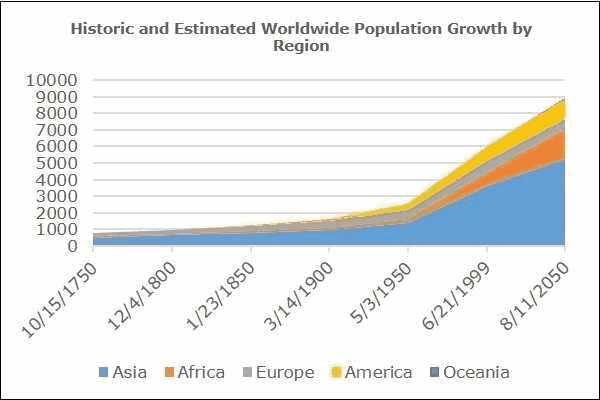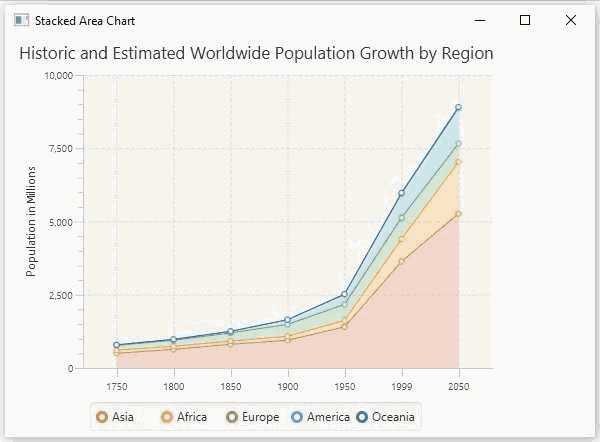JavaFX Stacked Area Chart(堆积面积图)
本文于2047天之前发表,文中内容可能已经过时。
StackedArea Chart是Area Chart的变体,显示每个值的贡献趋势(例如 - 加班)。堆叠区域使每个系列相邻,但不与前面的系列重叠。这与区域图表形成对比,其中每个系列覆盖前面的系列。
以下是描绘人口增长的堆积图表。

在JavaFX中,堆积区域图表由名为StackedAreaChart的类表示。该类属于包javafx.scene.chart。通过实例化此类,您可以在JavaFX中创建StackedAreaChart节点。
生成堆积面积图的步骤
要在JavaFX中生成堆积区域图表,请按照以下步骤操作。
第1步:创建一个类
创建Java类并继承包javafx.application的Application类。然后,您可以按如下方式实现此类的**start()**方法。
1 | public class ClassName extends Application { |
第2步:定义轴
定义堆积面积图的X和Y轴并为其设置标签。在我们的例子中,X轴表示从1750年到2050年的不同年份。这些年有50年的主要蜱单位。而Y轴代表数百万人口的增长。
1 | //Defining the X axis |
第3步:创建堆积面积图
通过实例化包javafx.scene.chart的名为StackedAreaChart的类来创建折线图。对于此类的构造函数,传递表示在上一步中创建的X轴和Y轴的对象。
1 | //Creating the Area chart |
第4步:准备数据
实例化XYChart.Series类并将数据(一系列,x和y坐标)添加到此类的Observable列表中,如下所示 -
1 | //Prepare XYChart.Series objects by setting data |
第5步:将数据添加到堆积区域图表
将上一步骤中准备的数据系列添加到堆积区域图表中,如下所示 -
1 | //Setting the data to area chart |
第6步:创建组对象
在start()方法中,通过实例化名为Group的类来创建组对象,该类属于包javafx.scene。
将上一步中创建的StackedAreaChart(节点)对象作为参数传递给Group类的构造函数。这样做是为了将其添加到组中,如下所示 -
1 | Group root = new Group(stackedAreaChart); |
第7步:创建场景对象
通过实例化名为Scene的类来创建一个Scene,该类属于包javafx.scene。在此类中,传递上一步中创建的Group对象(root)。
除了根对象之外,您还可以传递两个表示屏幕高度和宽度的双参数,以及Group类的对象,如下所示。
1 | Scene scene = new Scene(group ,600, 300); |
第8步:设置舞台的标题
您可以使用Stage类的setTitle()方法将标题设置为舞台。所述primaryStage是Stage对象,它被传递给场景类作为参数的启动方法。
使用primaryStage对象,将场景标题设置为Sample Application,如下所示。
1 | primaryStage.setTitle("Sample Application"); |
第9步:将场景添加到舞台
您可以使用名为Stage的类的方法setScene()将Scene对象添加到舞台。使用此方法添加前面步骤中准备的Scene对象,如下所示。
1 | primaryStage.setScene(scene); |
第10步:显示舞台的内容
显示场景的使用命名的方法的内容显示()的的阶段类,如下所示。
1 | primaryStage.show(); |
第11步:启动应用程序
通过从main方法调用Application类的静态方法**launch()**来启动JavaFX应用程序,如下所示。
1 | public static void main(String args[]){ |
例
下表列出了从1750年到2050年不同大陆的人口。
| 亚洲 | 非洲 | 欧洲 | 美国 | 大洋洲 | |
|---|---|---|---|---|---|
| 1750 | 502 | 106 | 163 | 18 | 2 |
| 1800 | 635 | 107 | 203 | 31 | 2 |
| 1850 | 809 | 111 | 276 | 54 | 2 |
| 1900 | 947 | 133 | 408 | 156 | 6 |
| 1950年 | 1402 | 221 | 547 | 339 | 13 |
| 1999年 | 3634 | 767 | 729 | 818 | 30 |
| 2050 | 5268 | 1766 | 628 | 1201 | 46 |
以下是一个Java程序,它使用JavaFX生成描述上述数据的堆积区域图。
将此代码保存在名为StackedAreaChartExample.java的文件中。
1 | import java.util.Arrays; |
使用以下命令从命令提示符编译并执行保存的java文件。
1 | javac StackedAreaChartExample.java |
在执行时,上述程序生成一个显示堆积区域图的JavaFX窗口,如下所示。
